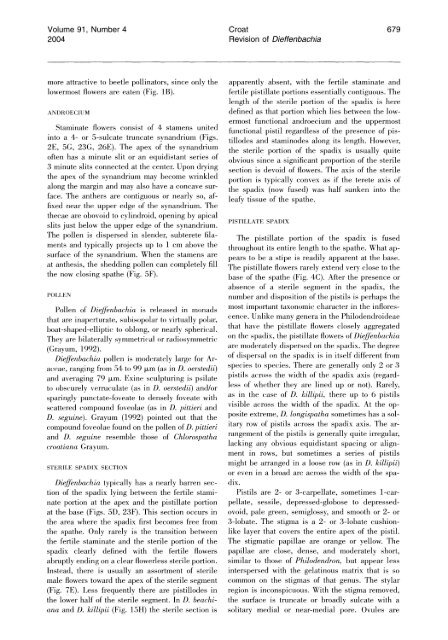l - CNCFlora
l - CNCFlora
l - CNCFlora
You also want an ePaper? Increase the reach of your titles
YUMPU automatically turns print PDFs into web optimized ePapers that Google loves.
Volume 91, Number 4<br />
2004<br />
Croat<br />
Revision of Dieffenbachia<br />
more attractive to beetle pollinators, since only the apparently absent, with the fertile staminate and<br />
lowermost flowers are eaten (Fig. 1B).<br />
fertile pistillate portions essentially contiguous. The<br />
length of the sterile portion of the spadix is here<br />
ANDROECIUM<br />
defined as that portion which lies between the lowermost<br />
functional androecium and the uppermost<br />
Staminate flowers consist of 4 stamens united functional pistil regardless of the presence of pisinto<br />
a 4- or 5-sulcate truncate synandrium (Figs. tillodes and staminodes along its length. However,<br />
2E, 5G, 23G, 26E). The apex of the synandrium the sterile portion of the spadix is usually quite<br />
often has a minute slit or an equidistant series of obvious since a significant proportion of the sterile<br />
3 minute slits connected at the center. Upon drying section is devoid of flowers. The axis of the sterile<br />
the apex of the synandrium may become wrinkled portion is typically convex as if the terete axis of<br />
along the margin and may also have a concave sur- the spadix (now fused) was half sunken into the<br />
face. The anthers are contiguous or nearly so, af- leafy tissue of the spathe.<br />
fixed near the upper edge of the synandrium. The<br />
thecae are obovoid to cylindroid, opening by apical<br />
PISTII,I,ATE SPADIX<br />
slits just below the upper edge of the synandrium.<br />
The pollen is dispersed in slender, subterete filaments<br />
and typically projects up to 1 cm above the<br />
surface of the synandrium. When the stamens are<br />
at anthesis, the shedding pollen can completely fill<br />
the now closing spathe (Fig. 5F).<br />
The pistillate portion of the spadix is fused<br />
throughout its entire length to the spathe. What appears<br />
to be a stipe is readily apparent at the base.<br />
The pistillate flowers rarely extend very close to the<br />
base of the spathe (Fig. 4C). After the presence or<br />
absence of a sterile segment in the spadix, the<br />
POLI,EN<br />
number and disposition of the pistils is perhaps the<br />
Pollen of Dieffenbachia is released in monads most important taxonomi( character in the infloresthat<br />
are inaperturate, subisopolar to virtually polar, cence. Unlike many genera in the Philodendroi(leae<br />
boat-shaped-ellipti( to oblong, or nearly spherie al. that have the pistillate flowers closely aggregate(l<br />
They are bilaterally symmetrie al or radiosymmetrie on the spa(lix, the pistillate flowers of DiefJenbachia<br />
(Grayum, 1992).<br />
are moderately dispersed on the spadix. The degree<br />
Dieffenbachia pollen is moderately large for Ar- of (lispersal on the spadix is in itself different from<br />
aveae, ranging from 54 to 99 1lm (as in D. oerstedii) spee ies to spee ies. There are generally only 2 or 3<br />
and avelaging 79 11m. Exine sculpturing is psilate<br />
pistils aeross the width of the spadix axis (regardto<br />
obs(urely verrueulate (as in D. oer.steflii) an(l/or<br />
less of whether they are lined up or not). Rarely,<br />
sparingly punctate-foveate to densely foveate with as in the ease of D. killivii, there up to 6 pistils<br />
scattered compound foveolae (as in D. pittieri and visible across the width of the spadix. At the op-<br />
D. seguine). Grayum (1992) pointed out that the posite extreme, D. Iongispatha sometimes has a solcompound<br />
foveolae found on the pollen of D. pittieri itary row of pistils across the spadix axis. The arand<br />
D. seguine resemble those of Chlorospatha<br />
rangement of the pistils is generally quite irregular,<br />
croatiana Grayum.<br />
lacking any obvious equidistant spacing or alignment<br />
in rows, but sometimes a series of pistils<br />
STERILE SPADIX SECTION<br />
might be arranged in a loose row (as in D. killipii)<br />
or even in a broad arc across the width of the spa-<br />
Dieffienbachia typically has a nearly barren sec- dix.<br />
tion of the spadix lying between the fertile stami- Pistils are 2- or 3-carpellate, sometimes l-carnate<br />
portion at the apex and the pistillate portion pellate, sessile, depressed-globose to depressedat<br />
the base (Figs. 5D, 23F). This section occurs in ovoid, pale green, semiglossy, and smooth or 2- or<br />
the area where the spadix first becomes free from 3-lobate. The stigma is a 2- or 3-lobate cushionthe<br />
spathe. Only rarely is the transition between like layer that covers the entire apex of the pistil.<br />
the fertile staminate and the sterile }ortion of the The stigmatic papillae are orange or yellow. The<br />
spadix clearly defined with the fertile flowers papillae are close, dense, and moderately short,<br />
abruptly ending on a clear flowerless sterile portion. similar to those of Philodendron, but appear less<br />
Instead, there is usually an assortment of sterile interspersed with the gelatinous matrix that is so<br />
male flowers toward the apex of the sterile segment common on the stigmas of that genus. The stylar<br />
(Fig. 7E). Less frequently there are pistillodes in region is inconspicuous. With the stigma removed,<br />
the lower half of the sterile segment. In D. beachi- the surface is truncate or broadly sulcate with a<br />
ana and D. killipii (Fig. 15H) the sterile section is solitary medial or near-medial pore. Ovules are<br />
679

















